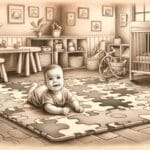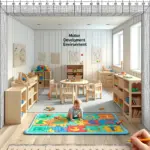For new parents, tracking your baby’s development and celebrating their milestones can be an incredibly rewarding experience. Every giggle, grin, and look your baby shares is a sign of their growth, particularly as they approach the two-month milestone. This period is characterized by significant advancements in social, emotional, and communication abilities, often leaving parents both excited and curious about the developments to come and how to best nurture their infant’s progress. In this comprehensive guide, we will explore the essential milestones for 2-month-olds, providing valuable strategies and advice to aid in your baby’s development, with a focus on optimizing for “2-month-old milestones”.
Understanding 2-Month-Old Milestones
At two months, your baby is on the brink of numerous developmental breakthroughs, each opening new avenues for learning and interaction. Let’s explore these milestones across various domains:
Social and Emotional Growth
- Facial Recognition: The joy of your baby recognizing your face is unparalleled. This significant social milestone signifies cognitive and emotional development, strengthening the bond between you and your baby.
- Responsive Smiling: Witnessing your baby’s first genuine smiles in response to your interactions is a heartwarming milestone, highlighting their advancing social engagement.
- Comfort Seeking: Your touch becomes a sanctuary for your baby, showcasing the importance of physical comfort in their emotional well-being.
Communication Breakthroughs
- Babbling and Sounds: Beyond crying, your baby starts to experiment with sounds, laying the foundation for future verbal communication. Baby babble: because starting a podcast at 2 months old is totally reasonable.
- Reaction to Voices: Noticing your baby’s calmness or joy at hearing familiar voices illustrates their growing auditory recognition and emotional connection.
- Visual and Auditory Tracking: The ability to follow objects and sounds not only marks a milestone in sensory development but also in cognitive growth, as your baby begins to understand the world around them.
The Marvel of Motor Reflexes:
At two months old, your baby is in the midst of what’s known as the ‘reflexive stage’ of development. These are not just random movements but are critical for their neurological growth. Here’s a closer look:
1. Moro Reflex (Startle Reflex):
- When It Occurs: Present from birth and typically fades by 2 to 4 months.
- What It Is: A response to loud sounds or sensations of falling, where your baby throws their arms and legs outward and then retracts them, often accompanied by a brief startle.
2. Sucking Reflex:
- When It Occurs: From birth, diminishing around 3 to 4 months but continues due to feeding.
- What It Is: Automatic sucking when the roof of the baby’s mouth is touched, facilitating feeding.
3. Rooting Reflex:
- When It Occurs: From birth, disappearing around 3 to 4 months.
- What It Is: When the baby’s cheek is stroked, they turn their head and open their mouth to “root” for the breast or bottle, aiding in feeding.
4. Palmar Grasp Reflex:
- When It Occurs: From birth, fading around 5 to 6 months.
- What It Is: An automatic gripping of objects (or fingers) placed in the baby’s palm.
- Encouraging the grasp reflex is highly beneficial, as Maria Montessori believed that the development of intelligence is greatly facilitated through the use of hands; this practice can expedite the fading of the reflex, resulting in earlier onset of deliberate hand movements.
5. Plantar Reflex:
- When It Occurs: From birth, disappearing by 9 to 12 months.
- What It Is: Curling of toes when pressure is applied to the bottom of the foot.
6. Stepping Reflex:
- When It Occurs: From birth, usually gone by 2 months.
- What It Is: “Walking” movements when the baby’s feet touch a flat surface, though this may have faded for your baby.
7. Galant Reflex:
- When It Occurs: From birth, phasing out by 2 to 4 months.
- What It Is: Sideways flexing of the body when the spine is stroked.
Vision and Hearing Reflexes:
Your baby is also developing reflexes related to their senses:
- Blinking Reflex: Protects the eyes from bright lights or fast-approaching objects.
- Pupillary Reflex: Contraction of the pupil in response to bright light.
- Auditory Startle Reflex: Turning the head towards a sound or startling at loud noises, indicating functional hearing and the ability to locate sounds.
Beyond Reflexes:
While these reflexes dominate your baby’s movements, they’re also starting to fade, making way for voluntary actions. This transition marks significant neurological development and paves the way for more intentional movements and interactions.
How to Support Your Baby's Development:
- Tummy Time: Essential for strengthening neck and shoulder muscles.
- Engaging and Talking: Stimulates language development and emotional bonding.
- Varied Sensory Experiences: Introduce different textures, sounds, and visuals to enrich their sensory world.
Fostering Your Baby's Development
Supporting your baby’s growth during this critical period involves simple yet impactful activities:
- Engage in ‘Conversations’: Talk and sing to your baby frequently. This not only nurtures your bond but also stimulates language development.
- Encourage Tummy Time: Strengthening neck and shoulder muscles, tummy time is crucial for physical development.
- Reading Time: Introducing books early fosters a love for reading and stimulates cognitive and language skills.
- Responsive Interaction: Acknowledge and respond to your baby’s coos and smiles. This positive reinforcement encourages further communication.




